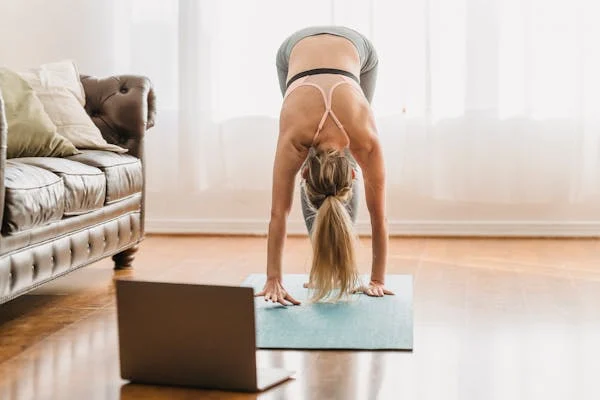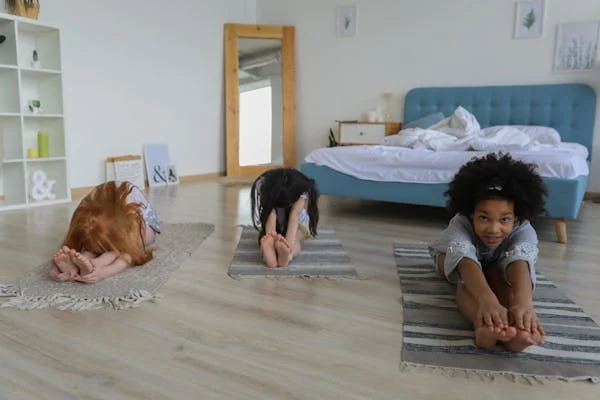Table of Contents
INTRODUCTION
yoga routine for flexibility is more than just the ability to bend and stretch; it’s a critical component of your health, well-being, and success. Flexibility can become a game changer in our modern, stressful world, too often linked with physical tautness and cruising stress.
The best ways to improve flexibility would be Yoga–just a wonderful combination of stretching exercises with mindfulness. Here is a blog on how flexibility Yoga helps improve not only your body but also your personal and professional life. Introduction
Imagine life in a body that flows gracefully and easily, without stiffness, tightness, or aches. Imagine the clarity of your mind and the flexibility of your body, reinforcing each other to meet challenges with grace and confidence.
This is what yoga promises to do—a stretching exercise to end all stretching exercises.
It’s more of a physical activity; it’s a whole workout, creating a balance between the body and the mind. Flexibility enhancement is one of the great benefits of yoga.
If you include a regular flexibility yoga practice in your routine, you’ll get improvements in physical potentials, less stress, and a general increase in well-being. You’ll eventually be able to perform better at the personal and professional levels.
Purpose of the Blog:
This blog would extend further by taking the idea of being flexible more understandingly, how yoga helps in being flexible, what are the primary yoga poses that are to be made, and finally, the inclusion of a regular yoga routine in a person’s personal and professional life that conveys a positive reflection.
We shall also highlight some practical tips on how to bring a yoga routine well into one’s day.
The Importance of Flexibility in Daily Life
Why Flexibility Matters
Flexibility is a trumped-up quality when it comes to the fitness and wellness chase, yet it plays an extremely supportive part in ensuring health and active living.
Flexibility means the ability to stretch muscles and move joints fully. Flexibility affects motion%, feelings%, and the efficiency of the performance in ordinary everyday activities.
• Physical Benefits: Greater flexibility minimizes the chances of various injuries up to a great extent because it provides free movement to the muscles and joints. It also helps to keep the correct posture of the body and relieves muscles from soreness and pressure.
• Mental Benefits: Flexibility is not only physical in nature; it’s much about frame of mind. If you are able to move with greater ease and minus the discomfort, then additionally you would attain a lot more upbeat feeling about life.
Moreover, in the situation of performing yoga, flexibility and the process of achieving it could be a meditation in itself since it cleans the mind and provides a release from tension .
Flexibility as the Key to Success:
Yoga Routine for Flexibility in personal and professional areas is considered equivalent to adaptability. A flexible body begets a flexible mind and helps in better dealing with change and stress.
When one is at the helm of a team, family, or individual goals, being agile and tough when under pressure goes a long way in making sure a person can see things throughstretching exercises.
Yoga: Flexibility at its Best
How Yoga Helps in Flexibility:
Yoga is a physical, mental, and spiritual practice that is aimed at developing flexibility, among other things. This increased flexibility is the primary benefit directly associated with this practice.
However, while most forms of workouts offer flexibility, yoga does so in a very gradual way, enjoining one’s body slowly without threats of injury.
• Stretching Exercises: These are indeed just stretching exercises to diverse muscle groups. That is, yoga postures really help in elongating muscles along with increasing blood flow and finally enhancing the range of motion within joints.
Over time, this enhances flexibility, which will make everyday movements easier and less tasking.
Holistic Approach: Flexibility training in yoga is holistic. Flexibility is concerned not only with physical movement ability but it also inspires mental and emotional flexibilities.
Mindfulness teaches us to listen to our body and its limits, as we gently push it to its limits in a safe and controlled way. Benefits that are obtained by practicing yoga regularly:
Flexibility can be gained through consistency with yoga. stretching exercises One will gain and maintain flexibility through a regular routine in yoga, thereby just making it a lifestyle.
• Physical Benefits : Consistency in yoga stretching exercises improves muscle tone, attaining better posture, and preventing the risk of injury. It helps get over chronic pain, which arises from stiffness in the back, neck, and shoulders.
• Mental and Emotional Gains: The regular practice of yoga definitely improves flexibility within the body. More importantly, though, it enhances flexibility within the mind. The mental elasticity of dealing with stress better makes you more resilient in personal and professional aspects of life.
3. Must-Know Yoga Stretches
Yoga poses could be added to the mix to help boost flexibility. Generally, all exercises include body muscles or target other muscles in any way, thus stretching most of the muscles.
• Downward-Facing Dog (Adho Mukha Svanasana): stretching exercises This is one pose that is so associated with so many basic sequences, and for good reason. It works to open the hamstrings, calf muscles, and shoulders, along with working to strength the arms and legs all in one fell swoop.
Downward-Facing Dog is probably the best pose for overall flexibility and for easing tension in the spine.

• Standing Forward Bend (Uttanasana): This is another stretch that hits the spine and hamstrings. The pose lengthens almost everything, be it the tension that comes with overactivity in the back or shoulders. This would really be the key take-home for any kind of yoga regimen for the purpose of enhancing flexibility.


• Seated Forward Bend (Paschimottanasana): This creates a stretch from the heels through the length of the back that is articulated, all the way up to the spine. The pose is all good, particularly at the forefront in helping unleash flexibility right from the hamstrings down to the lower back, which usually develops some tightness.


• Setu Bandhasana (Bridge Pose): A posture in the lift of the body from the chest, neck, and spine; it also reinforces the back and glutes. This is fantastic for flexibility in the spine and chest opening and shoulder widening.


Butterfly Pose: Baddha Konasana, which is going to relax the hips and the groin, areas that are tight in most individuals. Butterfly Pose is going to be very effective in loosening the hips, one of the essential parts in flexibility for any category.
Stretching Exercises—How to Integrate
In fact, stretching can also be considered a stretching exercise in itself, so such a yoga routine really suits a flexibility course. If done often, such poses develop flexibility in your joints and muscles.
• Focused Stretching: Focus should be on the groups that require it most. stretching exercises If the hamstring is tight, poses like Standing Forward Bend and Downward Dog have to be incorporated the regime.
• Balanced Approach: Although flexibility has to be site specific, total flexibility routine should also work in a progression through all the major muscle groups in order to develop balanced flexibility.


4. Designing a Flexibility Yoga Personal Program
Designing Your Program:
You could do this by designing a Flexibility Yoga personal program, which would mean you would use those poses that would work with the degree of your flexibility at present and would gradually move out of this comfort zone to learn to expand this flexibility.
• Evaluate Your Flexibility Level: Understand your present level of flexibility.
It will help you select, and understand how much time you need to give for a given asana.
• Choose the Right Poses: According to your level of flexibility, choose poses which target the areas of flexibility that are most desired to be improved. In case you are a beginner, follow the poses in the basic category, and gradually shift to medium-tough ones when your body becomes flexible.
• Structure the Body of Your Session: stretching exercises The actual great flexibility yoga session is going to consist of a general warm-up, the main workout through a series of poses, and a cool-down.
The purpose of the warm-up is to ready the muscles and joints for a stretching work-out. The purpose of the cool-down is to allow the muscles to relax and avoid stiffness.
Conformity Is Critical:
The best results to be achieved from a stretching exercises yoga session will come with regular practice. Small daily sessions will most certainly accumulate towards developments over quite some time.
• Start Small: If you are absolutely new to yoga or even flexibility training, you should start some of your physical activity really slow or keep it quite short. Slowly, as your flexibility increases, one may surely increase sessions’ duration and intensity.
• Stay Committed: Consistency is the key. Make your flexibility-yoga routine a no-excuse, non-negotiable part of your daily schedule. Whether in the morning, at lunch, or during the night, find a time that works and stick to it.
How Improved Flexibility Connects to Personal and Professional Success
Physical Gains
The flexibility gained by an individual comes with physical benefits that help enhance the quality of life and inject an impetus to succeed in almost every walk of life.
• Reduced Physical Discomfort: stretching exercises Flexibility in the body reduces muscle stiffness, soreness, and consequently enhances ease in handling daily chores. Whether it is sitting at a desk or lifting heavy objects, one can move better with flexibility, thereby domesticating initial tingling body discomforts.
Increased Energy – Flexibility also develops increased blood flow and lowers muscle exhaustion, which can also contribute to an increase in energy. This will keep you more sharp and on point longer throughout the day.
Mental and Emotional Benefits
Flexibility is not concerned too much with the body but more or less with the mind. The benefits of mental flexibility could be translated into better achievements in business and personal life.
• Improved Mental Toughness: Working on flexibility through yoga exercises helps to instill patience, persistence, and mental toughness.stretching exercises All these three together are very important for all to get success in one or the other aspect of life.
Better Stress Management: Stretching exercises in yoga release tension and stresses from the body, resulting in a calmer and more focused mind. Clearing the mind of mental clutter enables you to make better decisions, effectively handle stress, and maintain control even when under pressure.
